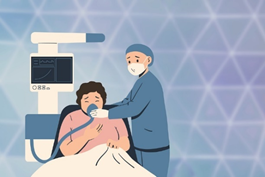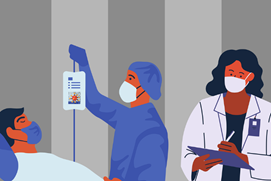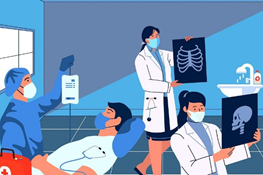ISO 22956:2021 Healthcare organization management
PAGE INFORMATION

CONTENT
ISO 22956:2021 Healthcare organization management Requirements for patient-centered staffing
[ Certification Introduction ]
Healthcare personnel works in very complex environments, including multiple generations and multicultural cultures, due to the need to maintain up-to-date information due to interdependent processes, increase of elderly severely hospitalized patients, and rapid development of medical knowledge and technology. Therefore, patient-centered staffing is emerging as an increasingly important area around the world within medical services, and medical institutions can strategically adopt that medical standard for patient-centered staffing.
Healthcare personnel monitor changes in the patient's health status and plan and develop appropriate treatment methods accordingly. They also play a more key and important role in treating patients, preventing side effects, and optimizing their health status and prognosis at the forefront of healthcare provision.
 <ISO 22956 Certification Introduction>
<ISO 22956 Certification Introduction>
Patient satisfaction is an important underlying concept in relation to the implementation of ISO 22956:2021, and the organization monitors the perception, views, needs, and expectations of the patient's experience are met. And healthcare personnel decide how to obtain and monitor, review information, including the following.
- • Surveys about service-specific through the patients
- • Patient focus group and quality management circles
- • Written expressions or comments and concerns
 <Patient-centered staffing principles>
<Patient-centered staffing principles>
[ Patient-centered staffing principles ]
Generally, the principles for patient-centered staffing are based on the following :
- • Considerations of patient safety
- • Risk management
- • Providing a uniform experience for patients
- • Working environment
- • Management of continuity in healthcare: in-patient (hospitalized) and out-patient (ambulatory) telemedicine and home hospitalization
- • Quality of healthcare
- • Organizational culture, leadership and people engagement
- • The distribution of a systematic process-based approach
- • Evidence-based decision making
- • Technology and innovation
- • Governance
- • The patient and service context
 <ISO 22956 Requirements>
<ISO 22956 Requirements>
[ ISO 22956:2021 Requirements ]
Patient-centered staffing considers the ISO 22956:2021 requirements to match personnel's expertise that provides healthcare service with the needs of the patient. This expertise should include a full range of professional experiences necessary to meet the patient's requirements while aiming for overall understanding and treatment of people or phenomena. Patient needs are related to age, family, home environment and personal situation, culture and disease type (acute or chronic).
In relation to ISO 22956:2021 requirements, it can indicate the need for organizations to plan and implement the actions required to address both risks and opportunities by monitoring process indicators.
Addressing both risks and opportunities for improvement is increases the safety of medical guidelines, achieving improved results and lays the foundation for preventing in advance a negative event that may occur.
- Scope
- Normative references
- Terms and definitions
- Determining the scope of the healthcare organization
- Leadership
- Risks, opportunities, expectations and perceptions
- Resources
- Analysis and evaluation
 <The importance of ISO 22956>
<The importance of ISO 22956>
[ The importance of ISO 22956:2021 ]
- 1. Identify patients rightly
- 2. Improve effective communication
- 3. According to guidance, ensure provided for high-caution degree medications (using drugs that can cause significant harm or cause devastating consequences for patients if administered wrongly) are given
- 4. Ensure safe surgery
- 5. Reduce the risk of healthcare-associated infections
- 6. Reduce the risk of patients' injury resulting from a falling
- 7. Prevent and treat a bedsore
- 8. If treatment is disrupted due to a lack of staff, it alleviates possible negative consequences
 <The necessity of ISO 22956>
<The necessity of ISO 22956>
[ The necessity of ISO 22956:2021 ]
Recently, the healthcare community is planning more progress on the concept of "patient-centered healthcare," and ISO is at the forefront of this development. Industry experts predict that the healthcare environment will change significantly different from the present in the next few years. It is considered will affect both healthcare workers and patients.
In addition, as the patient's own choice, utterance, and satisfaction level became the center of medical care, this empowerment has led the patient to make more choices regarding where and when to receive medical services and be treated through who.
Patients are in the most vulnerable state in dealing with their own health problems, so expectations for smooth and empathic treatment are bound to cannot help increasing. Therefore, health care organizations should develop a culture in which the concept of 'patient-centered care' is centered on the medical process so that the patient's experience is positive, as the patient's experience can be a measure of good treatment. It should be included the deployment of healthcare staffing.
ISO 22956:2021 provides guidelines to help hospital managers, leaders, decision-makers, risk managers and policymakers maintain appropriate manpower levels and establish a patient-centered healthcare culture.
 <The effect of ISO 22956>
<The effect of ISO 22956>
[ The effect of ISO 22956:2021 ]
-
By implementing ISO 22956:2021, the advantages that an organization can gain are as follows.
- • Improving compliance with legal, regulatory and professional requirements;
- • Increased transparency and accountability due to ease of resource allocation;
- • Provide greater opportunities for evidence-based decision making;
- • Improving the results of healthcare personnel staffing (e.g., By supplementing existing vacancies through recruitment and solving the problem of manpower reduction, narrowing the gap in healthcare personnel, and salaries, technology mixing requirements)
- • Management of various clinical and other service-related risks is possible;
- • Improving the ability to benchmark throughout the organization;
- • Meeting requirements and public health data such as the World Health Organization (WHO);
- • Improving organizational agility and efficiency, Improving quality through smooth communication between patients and treatment teams
-
By implementing ISO 22956:2021, the advantages that staff can gain are as follows.
- • Fatigue, exhaustion, and disease rate reduction;
- • Keep better manpower and prevent the decrease of manpower;
- • Improving job satisfaction and manpower capabilities;
-
By implementing ISO 22956:2021, the advantages that a patient can gain are as follows.
- • Improving visibility to all levels of manpower;
- • Meet requirements more effectively;
- • Improving Quality service;
- • Improved outcomes (e.g., a decrease of falls and medical-related infection rates, improve public health data: prevent medical, drug errors and hospital re-hospitalization, a decrease of patient mortality, Shorten the length of hospitalization)
- PREVISO 28000:2007 Supply Chain Security Management Systems 21.10.29
- NEXTIAF CertSearch - Check your certification 21.10.06
LIST OF COMMENTS
NO COMMENTS HAVE BEEN REGISTERED.

 한국어
한국어

